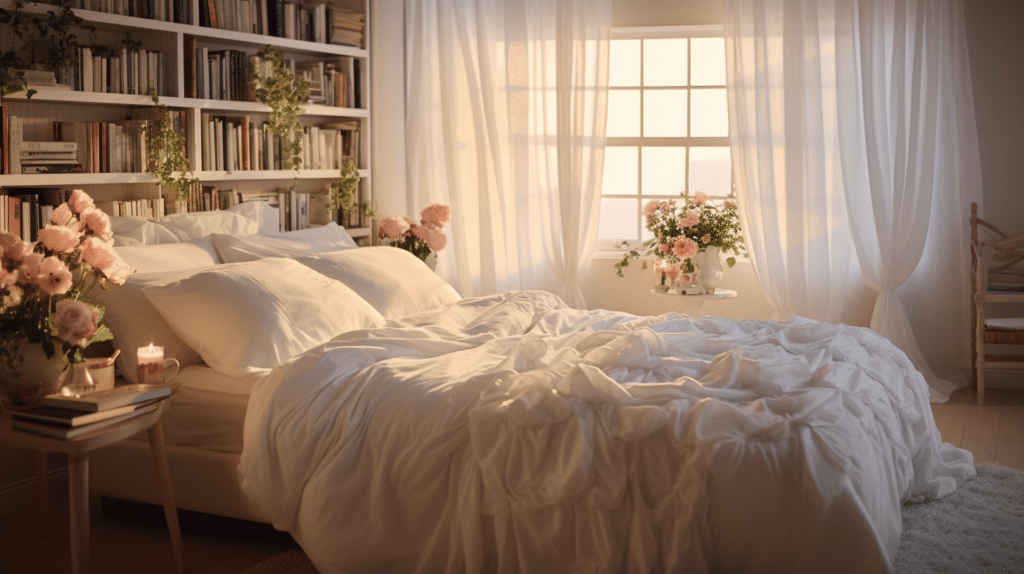Sleep is an essential biological process that plays a crucial role in maintaining overall health and well-being. While many factors can influence the quality of sleep, one often overlooked aspect is the temperature of our sleep environment. The optimal temperature for sleeping has been a topic of interest among researchers and sleep experts, as it can significantly impact our ability to fall asleep quickly and enjoy a restful night’s rest.
To understand the best temperature for sleeping, it is essential to consider the role of body temperature regulation in the sleep-wake cycle. Our body temperature naturally fluctuates throughout the day, with its lowest point occurring during nighttime sleep. This drop in body temperature signals the brain that it is time to initiate sleep and promotes feelings of drowsiness. Therefore, maintaining a cool room temperature can facilitate this cooling process and help us fall asleep faster.
Creating an environment conducive to good sleep involves more than just adjusting the thermostat; it requires a comprehensive approach that includes considering bedding materials, clothing choices, and other factors that contribute to thermal comfort during sleep. In this article, we will delve into the optimal temperature range for sleeping, explore how body temperature influences our ability to fall asleep, discuss strategies for achieving an ideal sleep environment, and provide practical tips to ensure a comfortable night’s rest. By understanding the relationship between temperature and sleep quality, individuals can make informed decisions about their sleep environment to optimize their overall well-being.
The Importance of Sleep Temperature
The optimal temperature for sleep is crucial as it creates a comfortable and conducive environment for one’s rest by promoting thermoregulatory balance and preventing disturbances caused by excessive heat or cold. Maintaining a cooler sleep environment has been shown to have numerous benefits for sleep quality. When the body is exposed to cooler temperatures, it triggers a drop in core body temperature, which in turn helps initiate and maintain sleep. This drop in temperature promotes the release of melatonin, a hormone that regulates sleep-wake cycles. Moreover, cooler temperatures help to decrease metabolic rate, resulting in deeper and more restorative sleep.
Research has consistently demonstrated the relationship between sleep quality and temperature. Studies have shown that sleeping in an environment with a lower ambient temperature leads to increased REM (rapid eye movement) sleep, which is associated with cognitive restoration and emotional regulation. Cooler temperatures also lead to decreased wakefulness during the night, reducing the frequency of awakenings and improving overall sleep efficiency. In addition to these direct effects on sleep architecture, maintaining a cooler bedroom can prevent discomfort caused by excessive sweating or feeling too hot under the covers. This can further enhance subjective feelings of comfort and relaxation during sleep.
The benefits of cooler sleep cannot be underestimated when considering optimal conditions for restful nights. The relationship between sleep quality and temperature highlights the importance of creating an environment that supports thermoregulatory balance. By maintaining a cooler bedroom temperature, individuals can promote deeper and more restorative sleep while reducing disruptions caused by excessive heat or cold. Incorporating strategies to maintain an optimal sleeping temperature can contribute significantly to overall well-being and ensure better quality of life through improved sleep patterns.
Optimal Temperature Range for Sleep
An ideal range of temperatures conducive to restful sleep exists. The optimal sleep temperature varies for each individual, but research suggests that a temperature between 60 and 67 degrees Fahrenheit (15.6 and 19.4 degrees Celsius) is generally considered the most suitable for promoting quality sleep. This range allows the body to cool down slightly, as our core body temperature naturally drops during sleep, facilitating more comfortable and uninterrupted rest.
Temperature regulation during sleep plays a vital role in maintaining a healthy sleep cycle. When we fall asleep, our bodies enter different stages of sleep where various physiological processes occur. One of these processes is thermoregulation, which involves the body’s ability to maintain its internal temperature within a narrow range. Cooling down the body aids in initiating and sustaining deep sleep, allowing for more efficient restoration of bodily functions. On the other hand, sleeping in an excessively warm environment can disrupt this natural cooling process, leading to discomfort and potentially reduced sleep quality.
Finding the optimal temperature range for sleep is essential for ensuring restful nights. While personal preferences may vary slightly, it is generally recommended to set the thermostat between 60 and 67 degrees Fahrenheit (15.6 and 19.4 degrees Celsius) to facilitate better quality sleep by supporting natural temperature regulation during restorative slumber.
The Role of Body Temperature in Sleep
Body temperature regulation plays a crucial role in the quality and restfulness of our sleep. Our body temperature naturally fluctuates throughout the day, following a pattern known as the circadian rhythm. The circadian rhythm is an internal process that regulates various physiological functions, including sleep-wake cycles. During the evening, our body temperature starts to decrease, signaling the onset of sleep. This decrease in body temperature promotes relaxation and helps us fall asleep more easily.
Maintaining a cool and comfortable sleeping environment can also aid in regulating body temperature during sleep. Research has shown that the optimal room temperature for sleep is between 60 to 67 degrees Fahrenheit (15 to 19 degrees Celsius). This range allows our bodies to cool down naturally, facilitating better sleep quality. When we are too hot or too cold during sleep, it can disrupt our natural thermoregulation processes and lead to difficulties falling asleep or staying asleep throughout the night.
Proper body temperature regulation is essential for achieving good-quality sleep. The circadian rhythm influences our body temperature throughout the day and night, with a natural decrease occurring in the evening to promote relaxation and facilitate sleep onset. Maintaining a cooler room temperature within the recommended range can further support this process by allowing our bodies to cool down naturally during sleep. By understanding and optimizing these factors, individuals can create an ideal sleeping environment conducive to restful nights of slumber.
The Cooling Process for Falling Asleep
Regulating body temperature during the sleep onset is crucial for a restful night’s slumber. As the body prepares for sleep, it naturally begins to cool down. This cooling process is an essential part of falling asleep and maintaining a deep, uninterrupted sleep throughout the night. There are various techniques that can aid in regulating body heat and promoting this cooling process.
One effective cooling technique is adjusting the ambient temperature of the sleeping environment. Studies have shown that a slightly cooler room temperature, around 65 to 70 degrees Fahrenheit (18 to 21 degrees Celsius), promotes better sleep quality. The cooler temperature helps lower core body temperature, signaling to the brain that it is time to sleep. Additionally, using breathable bedding materials such as cotton or linen can assist in dissipating heat and preventing excessive sweating during the night. These cooling techniques create an optimal environment for falling asleep and staying asleep throughout the night.
Regulating body heat plays a vital role in achieving a good night’s sleep. Implementing cooling techniques such as adjusting room temperature and choosing appropriate bedding materials can aid in initiating and maintaining the natural cooling process required for falling asleep. By creating an ideal sleeping environment, individuals can optimize their chances of experiencing restful and rejuvenating sleep each night.
Maintaining a Cool Room Temperature
Maintaining a cool room environment is crucial for optimizing sleep quality and promoting the natural process of falling asleep. Research has consistently shown that cooler temperatures facilitate the onset of sleep and improve its overall quality. When we sleep, our body temperature naturally drops to initiate and maintain a state of restfulness. By ensuring a cool room temperature, we can aid this cooling process and enhance our ability to achieve deep and restorative sleep.
There are several benefits associated with maintaining a cool room for sleeping. Firstly, cooler temperatures promote the release of melatonin, a hormone that regulates the sleep-wake cycle. Melatonin levels increase in response to darkness and lower temperatures, helping us feel drowsy and facilitating the transition into sleep. Additionally, cooler room environments prevent excessive sweating during the night, which can disrupt sleep by making us uncomfortable or causing us to wake up throughout the night. By maintaining an optimal temperature range between 60-67 degrees Fahrenheit (15-19 degrees Celsius), we create an environment that supports uninterrupted sleep and allows our bodies to fully rejuvenate during restorative REM cycles.
Maintaining a cool room temperature is essential for maintaining sleep quality and reaping the benefits of a good night’s rest. By providing an environment conducive to thermoregulation and melatonin release, we can optimize our chances of falling asleep quickly and experiencing deep, undisturbed slumber. Investing in measures such as using fans or adjusting thermostat settings can significantly contribute to creating an ideal sleeping environment that promotes overall well-being through improved sleep quality.
The Effects of a Warm Room on Sleep
One notable factor to consider is the impact of a warm room on sleep quality and overall sleep patterns. Research has shown that sleeping in a warm room can have negative effects on sleep quality. When the body is exposed to higher temperatures, it may struggle to regulate its internal temperature, leading to difficulties falling asleep and staying asleep throughout the night. High room temperatures can also disrupt the natural progression of sleep stages, particularly REM (Rapid Eye Movement) sleep, which is crucial for restorative functions such as memory consolidation and emotional processing.
On the other hand, maintaining a cooler sleeping environment has been associated with several benefits for sleep quality. Cooler temperatures help facilitate the decrease in core body temperature that naturally occurs during sleep, promoting a more efficient transition into deeper stages of sleep. Furthermore, cooler rooms tend to be less prone to excessive sweating or discomfort caused by heat, allowing individuals to maintain an uninterrupted and more restful sleep. In fact, studies have found that people generally experience better overall subjective sleep quality when they are able to achieve a cool room temperature conducive to optimal restfulness.
While sleeping in a warm room may adversely affect sleep quality by interfering with thermoregulation and disrupting normal sleep patterns, maintaining a cooler sleeping environment offers various benefits for achieving high-quality restorative sleep. By understanding and implementing strategies that promote an optimal sleeping temperature range, individuals can enhance their overall well-being by improving their nightly restfulness and optimizing their cognitive functioning during wakefulness.
Disruption of Sleep Cycle from High Temperatures
The previous subtopic discussed the effects of a warm room on sleep. Now, let’s delve into the disruption of the sleep cycle that can occur due to high temperatures. When the ambient temperature rises above a certain threshold, it can lead to discomfort during sleep, resulting in fragmented and restless nights. High temperatures can cause increased perspiration, making it difficult for individuals to maintain a comfortable body temperature. This discomfort can lead to frequent awakenings throughout the night, disrupting the natural progression of sleep stages.
To mitigate the negative impact of high temperatures on sleep, individuals often turn to various methods such as using fans. Fans provide an efficient way to circulate air and create a cooling breeze within a room. By increasing air movement and promoting airflow, fans help dissipate heat from our bodies and create a more comfortable sleeping environment. The benefits of using a fan extend beyond just providing relief from discomfort in hot weather; they also contribute to reducing humidity levels in the room by facilitating evaporation of moisture from our skin and bedding.
High temperatures can disrupt the natural sleep cycle by causing discomfort and frequent awakenings during the night. However, employing strategies like using fans can help alleviate these issues by improving airflow and creating a cooler environment for better quality sleep.
Tips for Achieving the Ideal Sleep Temperature
To optimize the conditions for a restful night’s sleep, it is crucial to create an environment that promotes optimal body temperature regulation. Maintaining a cool bedroom temperature can significantly impact sleep quality. When the room is too warm, it can be challenging for the body to cool down naturally, leading to discomfort and difficulty falling asleep. To achieve the ideal sleep temperature, there are several tips for staying cool at night.
Firstly, adjusting bedding materials can make a difference in regulating body temperature during sleep. Opting for breathable fabrics such as cotton or bamboo sheets allows air circulation and helps wick away moisture from the body. Additionally, using lightweight blankets or comforters made of natural fibers can prevent overheating while providing sufficient warmth if needed.
Secondly, proper ventilation plays a significant role in maintaining a cool sleeping environment. Opening windows or using fans can help circulate fresh air throughout the room and dissipate heat buildup. Placing a fan near the bed or using a portable air conditioning unit can provide additional cooling benefits.
Lastly, paying attention to personal habits before bedtime is essential when it comes to managing body temperature at night. Taking a cool shower or bath before sleep can lower core body temperature effectively. Furthermore, avoiding heavy meals close to bedtime can prevent metabolic heat production that may hinder comfortable sleep.
Creating an ideal sleep temperature involves implementing various strategies that promote cooling and comfort during nighttime rest. By following these tips for staying cool at night and understanding the impact of temperature on sleep quality, individuals can enhance their chances of achieving a restful and rejuvenating slumber.
Adjusting Bedding and Clothing for Temperature Control
Adjusting bedding and clothing for temperature control is an essential aspect of achieving the ideal sleep temperature. It is crucial to create a comfortable sleep environment that promotes restful sleep. One way to achieve this is by selecting appropriate bedding materials. Opting for breathable fabrics, such as cotton or linen, can help regulate body temperature during sleep by allowing air circulation and preventing overheating. Additionally, choosing bedding with moisture-wicking properties can be beneficial in managing sweat and keeping the body dry throughout the night.
Finding the right pajamas also plays a significant role in maintaining a comfortable sleep temperature. When it comes to bedtime attire, lightweight and loose-fitting garments made from natural fibers are recommended. These materials promote better airflow around the body and prevent excessive perspiration. Avoiding synthetic fabrics like polyester or nylon is advised since they tend to trap heat against the skin, resulting in discomfort during sleep. Furthermore, wearing multiple layers to bed can allow for easy adjustment according to personal preferences and changing temperatures throughout the night. By carefully selecting bedding materials and pajamas that facilitate proper ventilation and moisture control, individuals can optimize their sleeping conditions and improve overall sleep quality.
Creating a Sleep-friendly Environment
Creating an optimal sleep environment involves implementing strategies that promote restful and uninterrupted sleep. One important aspect of creating a relaxing atmosphere is to ensure that the bedroom is quiet, dark, and cool. Excess noise can disrupt sleep and prevent individuals from reaching deep, restorative stages of sleep. To eliminate unwanted sounds, it is recommended to use earplugs or white noise machines. Additionally, using blackout curtains or eye masks can help block out any light sources that may interfere with sleep. Maintaining a cool temperature in the bedroom is also crucial for promoting quality sleep. The ideal temperature for sleeping varies among individuals, but generally falls between 60 to 67 degrees Fahrenheit (15-19 degrees Celsius). This range allows for optimal comfort and promotes the body’s natural cooling process during sleep.
In addition to creating a relaxing atmosphere through environmental adjustments, aromatherapy has been found to be effective in promoting better sleep. Certain scents have calming properties that can help induce relaxation and improve overall sleep quality. Lavender, in particular, has been widely studied for its sedative effects on the central nervous system. Research suggests that inhaling lavender scent before bedtime can decrease heart rate and blood pressure, leading to a more restful state of mind conducive to falling asleep faster and experiencing deeper sleep throughout the night. Other scents such as chamomile and ylang-ylang have also shown promising results in improving sleep quality when used in aromatherapy practices before bed.
Overall, creating an optimal sleep environment involves ensuring a quiet, dark, and cool setting while incorporating aromatherapy techniques for enhanced relaxation. By following these strategies, individuals can set the stage for a more restful night’s sleep and wake up feeling refreshed and rejuvenated each morning.
Conclusion
In conclusion, finding the best temperature for sleeping is crucial for maintaining a good sleep quality. Research suggests that the optimal temperature range for sleep falls between 60 to 67 degrees Fahrenheit (15 to 19 degrees Celsius). This range allows the body to cool down and promote the onset of sleep.
Body temperature plays a significant role in regulating our sleep-wake cycle, and a cooler room temperature aids in initiating sleep by facilitating this cooling process. A cooler room also helps prevent disruptions in our sleep cycle that can be caused by high temperatures, such as restlessness and frequent awakenings throughout the night.
To achieve the ideal sleep temperature, it is recommended to adjust bedding and clothing accordingly. Opting for breathable fabrics and lighter blankets can help regulate body heat more effectively. Additionally, creating a sleep-friendly environment by keeping the bedroom dark, quiet, and well-ventilated can further enhance overall sleep quality.
Overall, understanding the importance of temperature in promoting healthy sleep patterns is essential. By maintaining a cool room temperature within an optimal range and making necessary adjustments to bedding and clothing, individuals can create an environment conducive to sound and restful slumber.


